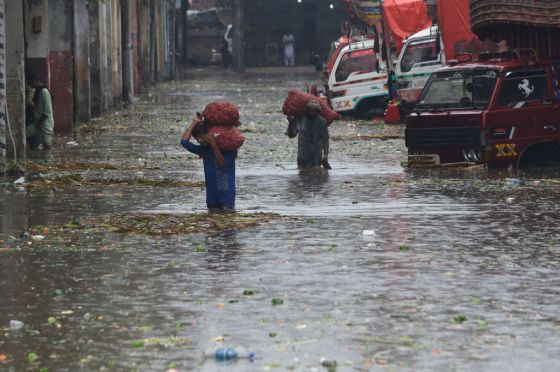Last Saturday in Mirpur Khas, a city in Pakistan’s Sindh province, hundreds of people lined up for hours outside a park to buy subsidized wheat flour, offered for 65 rupees a kilogram instead of the current, inflated rate of about 140 to 160 rupees.
When a few trucks arrived, the crowd surged forward, leaving several injured. One man, Harsingh Kolhi, who was there to bring a five kg bag of flour home for his wife and children, was crushed and killed in the chaos.
As the dust settled, a group of people at the site took Kolhi’s body to the local press club and demanded the registration of a murder case against officials responsible for the stampede as well as the flour crisis across the province, according to Dawn.
[time-brightcove not-tgx=”true”]
The incident is just one example of how the impact of the country’s burgeoning food shortage and a looming economic crisis are already being felt by Pakistan’s poorest.
As the country still reels from the devastating floods that hit over the summer, which government officials estimate damaged more than 80% of the country’s crops, it’s also contending with economic uncertainty that has left food and medicine lingering in ports. The State Bank of Pakistan says that their foreign exchange reserves have fallen to a critical level of $4.3 billion—barely enough for three weeks of imports.
Pakistan’s economic crisis is twofold, says Uzair Younus, Director of the Atlantic Council’s Pakistan Initiative. Even before last year’s floods, food inflation was already high, especially in rural areas, and many struggled to keep up with the rise in prices.
“Over the last four years, blue collar workers in Pakistan have lost around 30% of their purchasing power,” says Younus. “These are lower-middle-class and lower-class citizens that basically earn $2 a day.”
Before former Prime Minister Imran Khan’s party came to power in 2018, the government borrowed heavily in dollars to fund growth, keeping an overvalued exchange rate. By 2018, the policy of using an overvalued exchange rate could not continue because the country’s foreign exchange reserves were sharply down. Khan’s party was forced to turn to the IMF in 2019 for a $6 billion economic bailout.
The IMF program was suspended in March 2020 due to the arrival of COVID-19, and has undergone many starts and stops since then, as Younus says the government failed to meet some of the IMF’s demands.
In an effort to stretch dollars, imports are being held at the ports, impacting everything from food to medicine. “Containers of onions are stuck at port because the payments are not being cleared by the bank, so onion prices are now soaring,” says Younus. “In a country of 230 million on the verge of default, shortages are bound to pop up across the supply chain, especially for imported food and medicine.”

In December, Pakistan’s Poultry Association protested a two-and-a-half-month pending shipment of soybeans, a staple in the diet of chickens, which they said was leading to an increase of 162 rupees in the price of poultry—a 45% price hike. The country’s Ministry of National Health Services, Regulations and Coordination issued a warning that the country could soon face a shortage of life-saving drugs in the new future, as local banks are refraining from opening letters of credit for the import of medicines’ raw material.
During the International Conference on Climate Resilient Pakistan, a pledging conference hosted by the Pakistani government and the United Nations in Geneva earlier this week, the international community—including France, the EU, and China—pledged over $10 billion in loans to help Pakistan recover from flood damages.
The one-day conference was held to present a plan for a climate-resilient recovery, and raise continued assistance from the public and private sectors, shaping up to be a test case for having large emitters pay loss and damages for smaller emitters bearing the brunt of climate change. For now, Younus notes that they’re just pledges; it might be months until the funds materialize, and they’re likely to be allocated towards specific reconstruction plans.
When a deal might be reached “is anyone’s guess,” according to Younus. Pakistan has been in a deadlock with the IMF over $1.1 billion in funding since last September. The country’s army chief, General Syed Asim Munir, recently visited the UAE and Saudi Arabia in the hopes of securing additional loans from them.
The funds were dependent on various conditions—such as raising energy prices and taxes—which the Pakistani government has yet to meet. On his way out the door last April following a vote of no confidence, former Prime Minister Khan subsidized energy prices, just as the war in Ukraine was causing sharp increases in energy prices worldwide. “He was basically laying a minefield for the incoming government.”
With elections on the horizon this August (or possibly earlier, as Khan’s Tehreek-e-Insaf party is pushing to dissolve provincial assemblies in a bid for earlier elections), the government is unwilling to make any moves that might put them out of favor with voters. “A political party that is in power would not want to impose upward adjustments of prices and more inflation in the run up to an election.” says Younus. “Why inflict more pain on your citizens?”
In the meantime, Younus says, routines and decisions once considered mundane have become a lot more difficult. “You hear stories from doctors beginning to see adult malnutrition in adults who have given up two meals a day. You hear from teachers in schools saying that parents come and say ‘I have four children, can you tell me which one to keep in school? I cannot afford to pay the school fees for the other three.’”
“People cannot make ends meet,” Younus says. “Life is unbearable.”



0 Comments